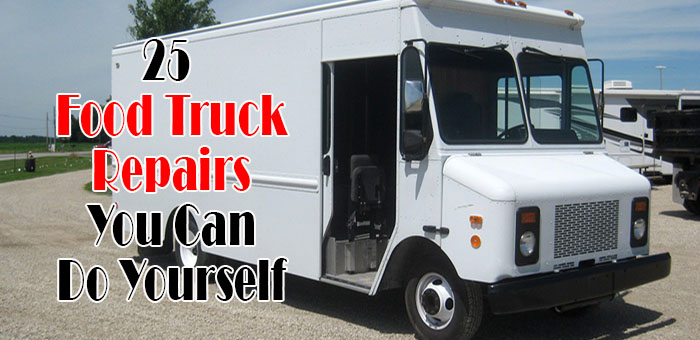Keeping your food truck on the road is a key to maintaining your mobile food business profitability. Modern trucks require expensive equipment and electronic diagnostics system to repair a lot of problems. You can’t do all types of food truck repairs on your own. In many cases, vendors need to either go to an authorized dealership or find a certified technician for more complex problems.
With that said, there are a lot of food truck repairs you can do yourself with simple tools and little experience. Save money and time by doing basic troubleshooting and repairs on many vehicle issues. Gain experience with your food truck’s complex issues by starting with completing these simple DIY repairs first.
Keep your mobile food business in top condition by following these 25 DIY food truck repairs
DIY Food Truck Repairs | Electrical
- Spark plugs. This simple DIY procedure can give your food truck better better fuel consumption ratings and drive smoother. Spark plugs for most food trucks are inexpensive. Check the plug wires while replacing spark plugs too.
- Headlight bulbs. Check the front of your truck for burnt headlight bulbs in need of replacement. DIY headlight bulb change is possible for trucks without sealed beam headlights. Be sure to get the right bulb for your truck and save money by changing it yourself.
- Blown fuses. If your headlights are out, it could be from a blown fuse. Check the truck’s fuse box to determine which fuse needs replacing. There are three main types of vehicle fuses, (glass tube, blade, or ceramic). Review your truck’s owner’s manual to find the location of fuse boxes and type of fuse required.
- Turn signal relays. Turn signals are easy to troubleshoot, if signal relays are at fault. Bad turn signal relays can make turn signals stop blinking. Check the signal relay setup of your truck for turn signal issues.
- Batteries. Batteries are the center of a truck’s electrical mechanism. Use approved gloves and eye protection to avoid acid damage from the battery. Check the old battery with a voltmeter to see if it has the proper charge. Batteries with lower than 9.7 volts while starting an engine, should be replaced for most vehicles.
RELATED: 3 Ways To Protect Your Food Truck From Electrical Hazards
DIY Food Truck Repairs | General
- Dangling exhaust pipes. If you hear rattling from the back of your truck, it could be damaged pipe holders or structure. Most trucks use rubber lined metal loops to hold exhaust pipes and can be damaged over time. Look under your vehicle for any broken hangers and change accordingly.
- Removing stripped screws. If you have damaged screw heads, steps must be taken to remove it correctly. Drills are suggested to remove stripped screws with diameters to drill a hole in the screw’s head center. Once the screw’s head separates from the body, it will be easy to remove.
- Seat belts and retractors. Seat belts, by law, must be used to protect against injury in a vehicle accident. Belts and belt retractors can be replaced with a screwdriver and/or wrench by simply removing the covers and placing new ones. You should test the new seat belt for proper working conditions.
- Washer tanks. Washer tanks are necessary to clean dirty windshields while on the road. Open your food truck’s hood and locate the washer tank. Remove the washer pump wiring to the washer tank before removing. Washer tanks are usually just held by a couple of bolts based on manufacturer. After replacement, fill the tank with washer fluid and make sure it is working properly.
- Weather striping. Inspect the weather strips for missing parts, cracking, or other damages for replacement. Worn out weaterstriping can allow water damage, if not kept in good condition.
DIY Food Truck Repairs | Cooling System
- Thermostats. Radiator thermostats help a truck’s engine maintain working temperatures that are within recommended levels. The radiator must be checked for leaks and locate the thermostat. Coolant should be drained to release pressure and to replace the thermostat housing structure faster.
- Hoses. Radiator hoses are key to maintaining coolant system pressures and engine temperatures. Worn out radiator hoses can leak and drain coolant levels. Check the upper and lower radiator hoses for damage and replace as necessary. Radiator hoses are usually just held by clamps and screws.
- Car radiator flush. Truck cooling systems and radiators should be cleaned to keep engines cool. Radiators can build deposits what can clog the cooling system. Perform regular radiator flushes to keep the cooling system in optimal condition. Before removing the radiator cap, to flush the radiator, check that the engine is cool.
DIY Food Truck Repairs | Oil System
- Change oil. Oil changes are relatively easy to do yourself with certain precautions. Avoid changing oil after driving your food truck recently since it can be very hot. You should wait at least a couple of hours after driving your truck to change the oil. Tools for a DIY oil change are ratchet, oil filter, wrench, funnel, new oil, oil container, and oil filter.
DIY Food Truck Repairs | Fuel Sysytem
- Filters. Fuel filters on average cost $15 depending on the engine, but can save hundreds of dollars from engine damage if changed regularly. Fuel filters are important to keep fuel injection and carburetor fuel systems clean and working properly. Please note; it is important to relieve the fuel system pressure before replacing the fuel filter to avoid damage or injury.
- Fuel gauge sending unit. If you are running low on fuel on a constant basis, the fuel tank gauge might need replacing. Many cars have these units located under seats based on the manufacturer. Review the owner’s manual to verify the location of the fuel sender unit, and if accessible, change accordingly.
DIY Food Truck Repairs | Mechanical
- Air filter replacement. Clogged air filters lower a truck’s performance at many levels. Change your food truck’s air filter to increase power and gas mileage. An air filter replacement is one of the easiest DIY food truck repairs to do for worn out filters.
- Serpentine belts. Check under your the hood for the serpentine belt routing layout. The belt tensioner must be located and loosened up to remove the serpentine belt. Install the new serpentine in the same manner that the old one was routed. After installing the new belt, check the belt’s tension and adjust if necessary.
- Windshield wipers. Replace the worn out strips of rubber found on old wipers with new ones. Change windshield wipers for optimal visibility during rain. Basic tools needed to change out wipers is a screwdriver.
RELATED: 5 Common Vehicle Maintenance Mistakes Food Truck Owners Can Avoid
DIY Food Truck Repairs | Tires/Brakes
- Pads. Always keep brake pads in optimal conditions to avoid accidents and injury. Brake pads are a key component of the brake system that should be properly maintained. Usual tools to change brake pads are a c-clamp, lug wrench, Allen wrenches, hammer, and jack.
- ABS sensors. ABS sensors can cause the ABS light to light up on your dashboard if dirty. Clean ABS sensors while replacing brake pads to save on time, if possible.
- Discs. Combine changing warped brake discs with brake pad replacement to save time if needed. Warped brake discs can damage your truck’s axles if it isn’t corrected in time.
- Tire valve stems. Tires and wheel assemblies must be removed to change tire valve stems. Deflate tires by removing the inside valve stem. Install the new tire valve and inflate tire accordingly.
- Plug tires. Some vehicle experts differ on whether is better to patch or plug a tire. Use these options only for short-term solutions for tire damage if it isn’t done by a professional. Tire plugs can be bought for as little as $5 to repair most tires depending to the damage.
- Tire replacement. A standard tire change is one of the most common DIY repairs performed by vendors. Replace damaged tires with the spare tire by using the jack and tire changing tools available from most truck manufacturers. Make sure to hire a professional to balance your food truck’s new tires later.
RELATED: Checking Your Food Truck Tires For Wear
The Bottom Line
Regular truck maintenance and repairs are top priorities to keep your food truck’s away from mechanic shops. This DIY food truck repairs list will assist you to maintain your vehicle in optimal road conditions without spending a lot of money. Get professional assistance if you are unable to fix some problems yourself. Also, please remember to follow safety procedures at all times while doing DIY food truck repairs.
Have you made food truck repairs not included in this list? Share your thoughts on this topic in the comment section, our food truck forum or social media. Facebook | Twitter




